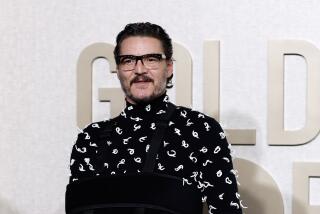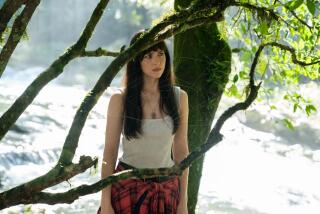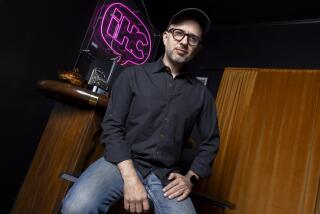James Mangold transforms the end of Wolverine into a new beginning with ‘Logan’
In Hollywood, the only thing more ubiquitous than superhero movies are complaints about superhero movies: that they are interchangeable and far too numerous. That watching cities destroyed via elaborate digital effects while squads of high-priced talent quip their way from one film to the next is a lesson in diminishing returns, both for the box office and for audiences.
Despite having now directed superhero star Hugh Jackman in two “X-Men” films, James Mangold is inclined to agree.
And that, he says, is precisely what fueled the success of “The Wolverine” and now “Logan,” which opened with an $88-million weekend, the biggest of the year so far.
“For a long time [I] wasn’t interested in what was going on in the comic-book arena of movies,” Mangold said during a recent interview from his office on the 20th Century Fox studio lot in Los Angeles, adding that he was, and remains, centered on making other kinds of movies.
“I think part of the attraction for Hugh and me working together again, even for the studio, is I bring a great deal of skepticism to the whole enterprise,” he said. “At every step I am trying to be skeptical about default settings of the genre, preexisting expectations of this particular franchise not because I’m hostile to what came before, more because on some level, I don’t know that I can make a good movie if I can’t have a little room.”
“Logan” has a built-in depth that other franchise films lack — it is being billed as the last time Jackman will play the role that made him an international star from the moment he bared his claws in 2000’s “X-Men.”
Even so, the film strives to do the opposite of what other comic book-derived superhero movies might do under similar circumstances. “Logan” has a pared-down cast rather than a bulging ensemble. It is dark and emotionally serious rather than brightly flip. And it is brutally violent, more than earning its R-rating, as opposed to looking away from the bloody damage that super-strength (or Wolverine’s famous claws) can inflict. “Logan” is in fact a movie of blood and consequences.
“On a creative level my hope would be that this strand of film, from the Fox logo to the end credits, would function for a person who has not seen a single ‘X-Men’ movie,’” Mangold said. “And I would almost count myself mentally as one of them, in that I don’t value any of these movies as franchises.”
Perhaps not surprisingly, Mangold has one of the more unpredictable résumés of contemporary studio filmmakers. After winning the directing prize at Sundance for his debut, the 1995 drama “Heavy,” he made “Copland” with a top-shelf cast that included Robert De Niro, Harvey Keitel and Sylvester Stallone. Angelina Jolie won an Oscar for her performance in Mangold’s 1999 film, “Girl, Interrupted,” and six years later Reese Witherspoon picked up hers for her role in his “Walk the Line.”
In between, Mangold worked with Jackman for the first time on the 2001 time-traveling romance “Kate & Leopold.” Mangold’s most recent films continued to leap across genres with the western “3:10 to Yuma” and the adventure caper “Knight and Day,” before he made “The Wolverine” in 2013.
The script to “Logan” is credited to Mangold, Scott Frank and Michael Green, from a story by Mangold, and combines elements from different series of “X-Men” comic books, notably one titled “Old Man Logan,” with some new elements created for the film.
Set in 2029, as the movie opens Jackman’s character Logan is lying low, concerned only with caring for the ailing Charles Xavier (Patrick Stewart) with the aid of the mutant Caliban (Stephen Merchant). They encounter a young girl named Laura (Dafne Keen, in her feature film debut) who has powers similar to Logan’s and is being pursued by a mercenary (Boyd Holbrook) and a nefarious scientist (Richard E. Grant). Soon, Logan, Laura and Xavier are on the road and on the run.
We were only scratching the surface of what was at stake here, what is the real cost of being that character.”
— Hugh Jackman on playing Wolverine

Kenneth Turan reviews “Logan,” directed by James Mangold, starring Hugh Jackman, Dafne Keen, Patrick Stewart, Boyd Holbrook, Stephen Merchant, Richard E. Grant. Video by Jason H. Neubert.
When Mangold and Jackman first began discussing the tone of the film, they referenced a wide array of movies, from the masculine twilight of “The Wrestler,” “Unforgiven” and “Shane” to the mobile family dysfunction of “Little Miss Sunshine.”
For Jackman, the story acknowledged a dimension to the character that had always been present in his years of playing Wolverine but had never before been fully explored.
“Over the 17 years I really felt we were only scratching the surface of what was at stake here, what is the real cost of being that character,” Jackman said. “The weight of what he’s done and who he is. It was Jim who said it to me first, so simply, he said, ‘everyone he has ever known or loved has died.’ Some of which he has been responsible for, so there’s a huge weight. And that was really what interested us.”
In crafting an R-rated character drama where the characters just happen to be superheroes, Mangold has made a movie more defined by its own story than the fabric of the other “X-Men” films.
“Logan” is not alone in its desire to be both singular and part of a larger tale. Like the many parts of the Marvel empire, last year’s “Deadpool” and the current television show “Legion,” both drawn from the “X-Men” universe, also play around with the loosely related franchise that audiences are increasingly willing to accept.
“I think if it was five or 10 years ago, it would be harder for a movie like ‘Deadpool’ or ‘Logan’ to break out into being a movie that mass audiences felt ready for,” said Simon Kinberg, a producer not only on “Logan” and numerous “X-Men” projects but also a part of the recent “Star Wars” series as well.
“But now that they’ve seen so many of these films, there’s a necessity to change it up, and almost to create a genre within the genre each time we make a movie,” Kinberg added. “So ‘Deadpool’ to some extent was like an R-rated comedy and ‘Logan’ is a western. And as we make other movies we ask ourselves, ‘what is the genre we’re exploring through a superhero comic-book lens?’”
The importance of having a dramatically inclined filmmaker like Mangold to wrap up the story of Wolverine on-screen was never lost on Jackman. He recalled shooting a pivotal, emotional scene with Keen, and how Mangold, recognizing that there was something more to be drawn from it, allowed additional time both for Jackman as a performer and for Logan as a character.
“And I’ll never forget that,” Jackman said. “It was a great moment as an actor, and for him to see that I was doing the scene, doing everything I should, but he wanted to just sit in it for a little bit and see what happens, as an artist.
“And when a director buys you 40 minutes of time where a producer would want to move on, that’s something you never forget.”
SIGN UP for the free Indie Focus movies newsletter »
Follow on Twitter: @IndieFocus
ALSO
‘What can cinema do?’ Travel ban puts Oscar nominees for foreign-language film in the spotlight
Isabelle Huppert breaks through with the fearless audacity of ‘Elle’
More to Read
Only good movies
Get the Indie Focus newsletter, Mark Olsen's weekly guide to the world of cinema.
You may occasionally receive promotional content from the Los Angeles Times.







